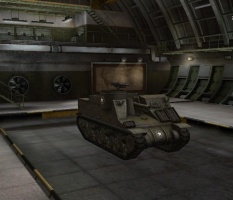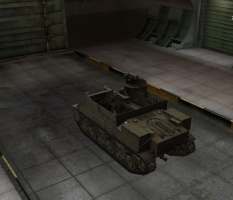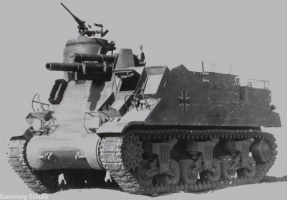M7 Priest
- For the medium tank, see M7.
M7 Priest
Mouse over "
[Client Values; Actual values in
| 47,000 |
| 25050 HP Hit Points |
| 23/23.112.58/25.5 t Weight Limit |
- Commander
- Gunner
- Driver
- Radio Operator
- Loader
- Loader
| 400500 hp Engine Power |
| 38.6/10 km/h Speed Limit |
| 1820 deg/s Traverse |
| 17.3939.75 hp/t Power/Wt Ratio |
| YesYes Pivot |
| // mm Hull Armor |
HE
HE Shells |
166/0
166/0 Shell Cost |
| 410//410// HP Damage |
| 27//27// mm Penetration |
|
3 r/m ▲
3 r/m Standard Gun ▲ Rate of Fire Standard Gun |
|
1230 ▲
1230 Standard Gun ▲ Damage Per Minute Standard Gun |
|
0.84 m ▲
0.82 m With 50% Crew: 1.041 m ▲ Accuracy With 50% Crew: 1.016 m |
| 5.5 s 5.5 s Aim time |
| 1616 deg/s Gun Traverse Speed |
| 38° Gun Arc |
| -5°/+45°-5°/+45° Elevation Arc |
| 120120 rounds Ammo Capacity |
| 2020 % Chance of Fire |
| 260 m 260 m View Range |
| 395 m 745 m Signal Range |
III

47000
The M7 Priest is an American tier 3 self-propelled gun.
Manufactured on the suspension of the M3 and M4 tanks from April 1942 through March 1945, with a total of 4,316 vehicles produced. The M7 Priest first saw combat at El Alamein.
The Priest has good reload time for an SPG, at the cost of being somewhat inaccurate and having poor splash damage - should it miss it will not deal significant damage to close targets. Also, hitting high tier enemies will almost always ping them for a meager amount of damage, which can be frustrating at times. With the 8.6 update it has changed from Tier IV to III with the previously Tier III M37 taking its place. Due to this it is considered to many players the most overpowered Tier III artillery.
The M7 Priest marks the end of its American self-propelled gun line.
Modules / Available Equipment and Consumables
Modules
| Tier | Suspension | Load Limit (т) |
Traverse Speed (gr/sec) |
Rmin | Weight (kg) |
Price (
| |
|---|---|---|---|---|---|---|---|
| II | VVSS T49 | 23.1 | 18 | 0 | 11000 | 590 | |
| III | VVSS T51 | 25.5 | 20 | 0 | 11000 | 1650 |
| Tier | Radio | Signal Range (m) |
Weight (kg) |
Price (
| |
|---|---|---|---|---|---|
| IX | SCR 506 | 615 | 110 | 33600 | |
| VI | SCR 508 | 395 | 100 | 21600 | |
| X | SCR 528 | 745 | 80 | 54000 |
Compatible Equipment
Compatible Consumables
Player Opinion
Pros and Cons
Pros:
- Very far gun range (990 meters) and very high alpha damage for a Tier III arty
- 102mm lower front plate can bounce even some Tier V guns
- Great engine power and acceptable top speed; good for relocating
- Surprisingly quick RoF for a 105mm Howitzer gives the Priest an acceptable DPM (1283)
- Can hold a very large amount of shells (69)
Cons:
- Although quick for a Tier III howitzer, the reload in general is slow; missing in a close quarters fight will cost your life
- Very sluggish traverse, you must be wary of flankers
- Armor is a lie -- 102mm is only on the lower plate, the entire superstructure is only 12mm thick
- Pretty inaccurate, even for an arty; misses are very likely to happen
- Tiny splash damage, even slightly missing yields little splash, if any
Performance
You cannot mount the upgraded gun without increasing your weight limit, so the suspension should probably be your first purchase. In fact you can't even equip a Camouflage Net without upgrading the suspension. Combined with the limited range of the stock cannon this can make the first few battles particularly hazardous. Once you get the upgraded gun, however, the range becomes excellent. The armor on the sides and rear is useless -- even the sloped upper front armor rarely bounces Tier I guns. However, perhaps this is because the Priest model used in the game was based on a unit built upon the chassis of a "Jumbo", perhaps because of a joke in the developer team related to the name of the vehicle, but the lower part of the Priest's front has an armor thickness that won't be seen again until the upgraded turret of the KV-1 Soviet heavy tank. This, coupled with a relatively high weight, makes it fairly resistant to ramming.
However, once fully upgraded it is the best Tier III hands down. With a fast reload coupled with insanely high damage you can one-shot any enemy you see. With the adjusted Tier III maps the only map it will be ineffective on is Himmelsdorf.
Early Research
- The upgraded suspension is an immediate necessity. Make it your first research project
- Research the 105 mm Howitzer M2A1 for much greater range
- Go from there
Suggested Equipment
Gallery
Historical Info
The 105 mm Howitzer Motor Carriage M7 was an American self-propelled artillery vehicle produced during World War II. It was given the official service name 105 mm Self Propelled Gun, Priest by the British Army, due to the pulpit-like machine gun ring, following on from the Bishop and the contemporary Deacon self-propelled guns.
History
Witnessing the events of the war, U.S. Army observers realized that they would need a self-propelled artillery vehicle with sufficient firepower to support armored operations. Lessons learned with half-tracks (such as the T19) also showed that this vehicle would have to be armored and fully tracked. It was decided to use the M3 Lee chassis as the basis for this new vehicle design, which was designated T32.
After reworking the M3 by providing an open-topped superstructure, mounting a 105 mm howitzer and, following trials, adding a machine gun, the T32 was accepted for service as the M7 in February 1942 and production began that April.
While the first M7s were produced for the U.S. Army, supply was soon diverted to support the Lend-Lease program. Ninety M7s were sent to the British 8th Army in North Africa, who were also the first to use it in battle during the Second Battle of El Alamein as well as their own Bishop: a 25-pounder, howitzer-armed self-propelled gun. The M7 soon proved successful and the British requested 5,500 of them: an order which was never fully completed. They did find problems with the M7 though, as the primary armament was of U.S., not British standard. This meant that the M7s had to be supplied separately, causing logistical complications. It was a problem that was only truly resolved in 1943 on arrival of the 25-pounder-armed Sexton developed by the Canadians on a similar chassis. Until that time though, the British continued to use the M7 throughout the North African Campaign, the Italian Campaign, and even a few during the early days of the Normandy Invasion. After the Sexton appeared, most British M7s were converted into "Kangaroo" armored personnel carriers.
In U.S. service, the M7 was a great success. Each U.S. armored division had three battalions of M7s, giving them unparalleled mobile artillery support.
A total of 3,490 M7s were built, and they proved to be reliable weapons, continuing to see service in the U.S. and allied armies well past World War II.
Variants
- M7 --The first M7s produced were modified M3 Lee medium tanks. In order to maintain a low silhouette, the howitzer elevation had to be restricted to 35°. In May 1942, after only a month of production, the vehicle was altered to increase it's ammunition storage from 24 to 69 rounds. This was achieved by placing seven rounds on the left wall, five on the right, and storing the remainder under floor plates. The M7 also went through a fairly rapid shift from being based on the M3, to having more commonality with the M4 Sherman. The first major example was an adoption of the M4's three-piece housing, single piece casting, and suspension. In British service, some M7s carried a radio set, which took the place of 24 rounds of ammunition.
- M7B1 -- Completing the shift, the M7B1 was fully based on the M4A3 Sherman chassis. It was standardized in September 1943, and declared the "substitute" standard in January 1945.
- M7B2 --During the Korean War, the limited elevation of the howitzer became noticeably problematic and it was increased to 65° to increase the effective range of the howitzer. The machine gun mount also had to be raised to give a 360° firing arc.
- Defrocked Priest -- As one part of the Allied effort to capture Caen and breakout from the Normandy beaches, several M7s had their main gun removed in the field for use as armored personnel carriers and were used in Operation Goodwood. These field modified vehicles were referred to as "Defrocked Priests."
- Kangaroo -- A Canadian armored personnel carrier (APC) conversion of the M7 for use by British and Commonwealth units in northern Europe. The Kangaroo could carry 20 infantry plus a crew of two. A total of 102 were converted between October 1944 and April 1945. The name "Kangaroo" became generic for all APC conversions of armored fighting vehicles no longer suitable for combat, including Ram conversions.
Historical Gallery
Sources and External Links
| USA | IIT1 HMC • IIIT18 HMC • IIIM7 Priest • IVT82 HMC • IVM37 • VM41 HMC • VIM44 • VIIM12 • VIIIM40/M43 • IXM53/M55 • XT92 HMC |
| UK | IILoyd Gun Carriage • IIISexton II • IIISexton I • IVBirch Gun • VBishop • VIFV304 • VIICrusader 5.5-in. SP • VIIIFV207 • IXFV3805 • XConqueror Gun Carriage |
| Germany | IIG.Pz. Mk. VI (e) • IIISturmpanzer I Bison • IIIWespe • IVPz.Sfl. IVb • IVSturmpanzer II • VGrille • VIHummel • VIIG.W. Panther • VIIIG.W. Tiger (P) • IXG.W. Tiger • XG.W. E 100 |
| France | IIRenault FT 75 BS • IIILorraine 39L AM • IVAMX 105 AM mle. 47 • VAMX 13 105 AM mle. 50 • V105 leFH18B2 • VIAMX 13 F3 AM • VIILorraine 155 mle. 50 • VIIILorraine 155 mle. 51 • IXBat.-Châtillon 155 55 • XBat.-Châtillon 155 58 |
| USSR | IISU-18 • IIISU-26 • IVSU-5 • VSU-122A • VISU-8 • VIIS-51 • VIISU-14-1 • VIIISU-14-2 • IX212A • XObject 261 |
| China | |
| Japan | |
| Czechoslovakia | |
| Sweden | |
| Italy | |
| Poland |






















